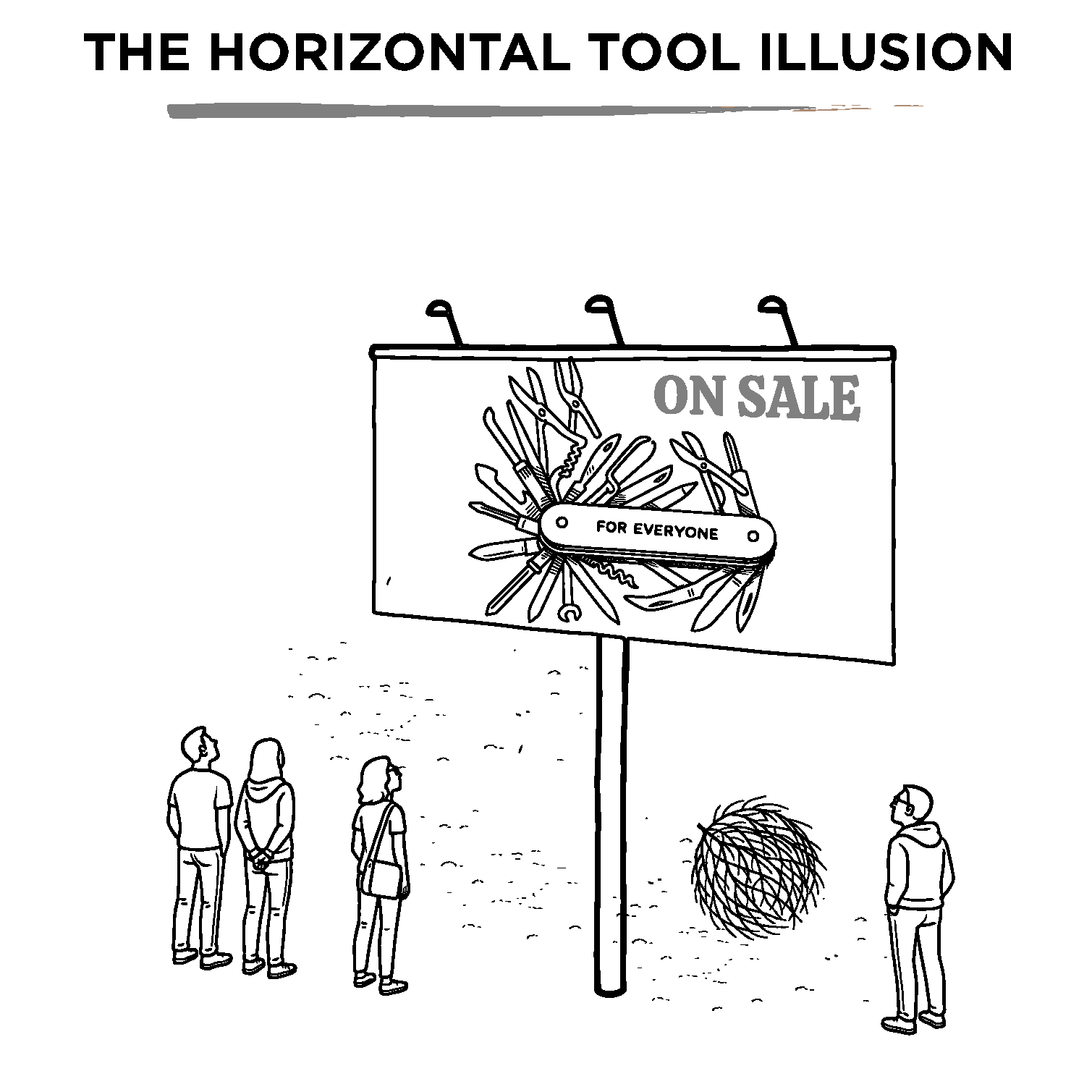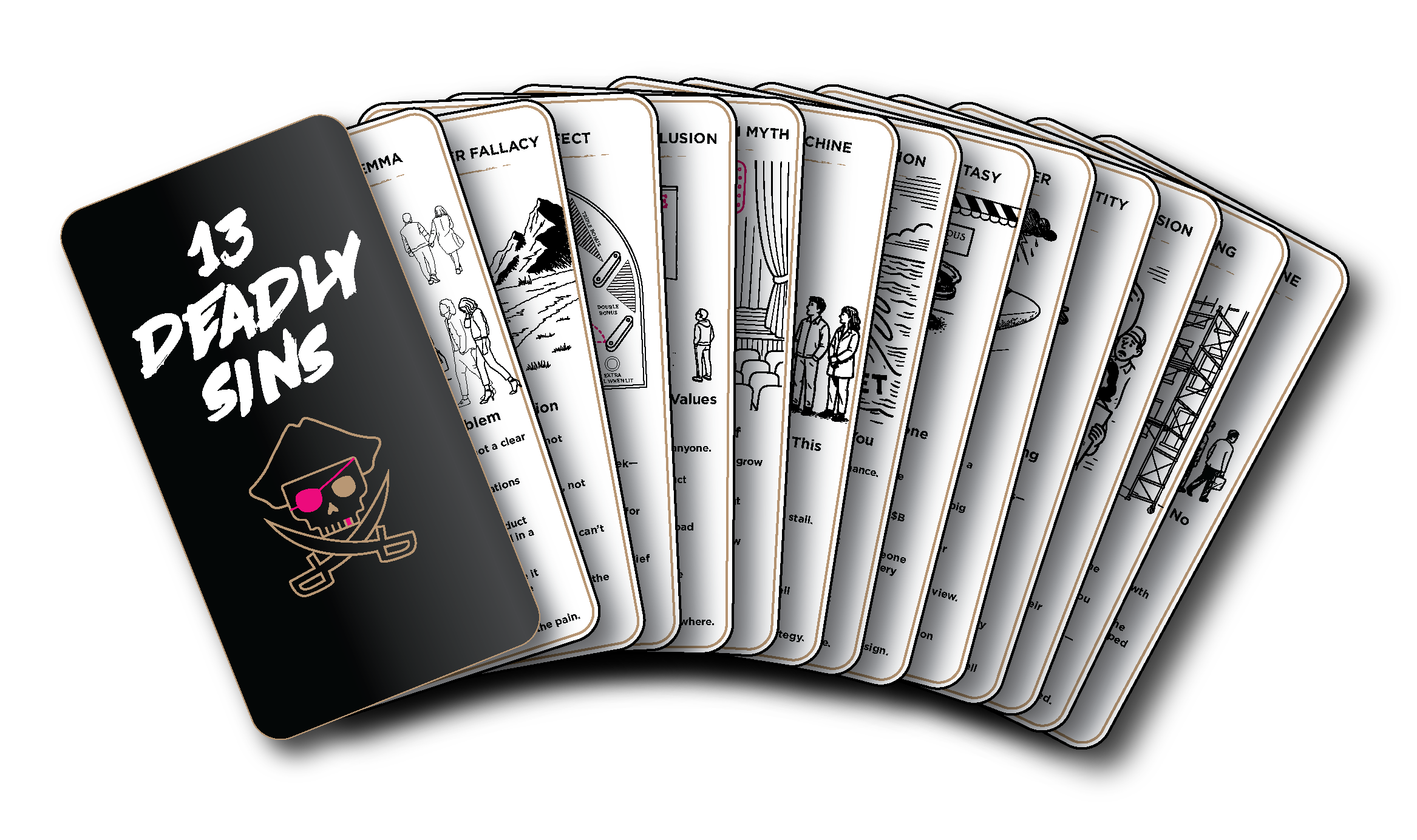
“Our product can do so many things … but we’re not getting credit for any of it.”
It starts as a strength.
Your product is flexible. Broad. Adaptable.
Everyone can use it.
But no one believes they need it.
That’s the danger of the Horizontal Tool Illusion.
You build a platform with wide applicability.
And the market responds … with confusion.
You’re not seen as strategic.
You’re not positioned as essential.
You’re admired—but not adopted.
You’re compared to everything—and chosen for nothing.
You’re not failing.
You’re just strategically invisible at scale.
This is one of the deadliest sins in the Define phase—because it feels like traction, but it’s actually an illusion.
What It Feels Like
| Usage across functions—but no clear buyer
| Customers say, “we love it”—but your deal size is small
| You’re winning logos, but not belief
| Every sales conversation starts with, “So … what do you guys actually do?”
You’re in the aisle—but the shelf you’re on doesn’t match your value.
Why It Happens
It happens when you prioritize product flexibility over problem clarity.
You build something that can be used by anyone.
But because it’s not designed for someone, no one fights for it.
The market doesn’t reward versatility.
It rewards specificity.
Broad utility might win attention.
But only clear problems create urgent demand.
Qualtrics: The Company That Escaped
When we first met CEO Ryan Smith and the Qualtrics team in Provo, they were already successful:
| A loyal user base
| A flexible product
| Strong revenue growth
| Unicorn status
But Ryan was frustrated:
“I keep getting called Survey Software on steroids.”
It wasn’t just inaccurate.
It was limiting.
Because deep down, Ryan knew what they were really building:
A system to help companies understand how people were experiencing their products, brands, and workplaces.
But no one could see it.
They were stuck in the Horizontal Tool Illusion.
Broad capability. Vague identity. No gravity.
The Bigger Problem
We started with a simple question:
“What do you actually get from a survey?”
Answer: insight into how someone feels—about a product, a service, a brand, a moment.
Human factors data—the feelings, expectations, and perceptions—was the real value.
We gave it a name: Experience Data (X Data).
And once we named it, everything shifted.
Ryan and his team realized:
“We’re not measuring transactions. We’re measuring experiences.”
The real problem wasn’t survey fatigue.
It was experience blindness—a massive misalignment between what companies thought they were delivering… and what people actually felt.
Naming the Villain
We called it: The Experience Gap.
To make it real, we backed it with data:
| 80% of CEOs believed they were delivering great experiences
| Only 8% of customers agreed
That 72-point delta became the villain.
Everyone felt it.
No one had named it—until now.
The Category: Experience Management
Once the Experience Gap was named, the solution became obvious.
To close the gap, companies needed a system to measure, understand, and act on X Data—across every part of the business.
We called it: Experience Management.
Shortened it to XM. And it stuck.
It wasn’t a feature.
It was a new layer of enterprise infrastructure—on par with CRM, ERP, and HCM.
And Qualtrics became the company that delivered it.
Internal Mobilization: The Burning of the Boats
The turning point came in a founder-led exec meeting.
Ryan walked the team through the full POV:
| The villain: The Experience Gap
| The vision: Revolutionizing Experience
| The category: Experience Management
| The Blueprint: XM across the enterprise
Then he said:
“I’m about to make a very big strategic step—from surveys to XM.
“And I want you all with me.”
One by one, every exec said yes.
That was the moment.
The Burning of the Boats.
From that day forward, Qualtrics wasn’t a survey company.
They were XM.
Lightning Strike: Reframing the Market
The external Strike came at Qualtrics’ annual Insights Conference.
3,000+ attendees.
And one huge shift.
Ryan stood on stage and reframed the problem:
“What you care about isn’t the survey—it’s what it measures.
"It’s experience.”
Then he dropped the stat:
“80% of CEOs think they’re delivering great experiences.
“Only 8% of customers agree.”
There was an audible groan.
Everyone in the room felt it.
Then came the platform:
The XM Platform
The Four core experiences of business:
CX (Customer Experience)
EX (Employee Experience)
PX (Product Experience)
BX (Brand Experience)
“These are the four corners of the modern enterprise.”
The POV landed.
XM was real.
And the market moved.
Outcomes
Qualtrics restructured around the XM Blueprint.
They stopped delivering survey tools—and started delivering systems.
| SAP acquired Qualtrics for $8 billion in 2018
| They went public in 2020 with a $27 billion market cap
| XM became their ticker symbol
Then came the next evolution.
In 2021, they realized that capturing X-data wasn’t enough. To truly understand the experiences of their customers and employees, companies needed actionable insights from every channel. The kinds of insights they could get without ever asking a question, based on customer service chats, social media, product reviews. And Omnichannel XM was born.
More recently, as generative AI has made it possible to understand and respond to every customer, Qualtrics is leading into the next seismic shift in XM by building AI Experience Agents to understand interactions. And create experiences tuned for human connection, based on decades of Experience Management.
They went from being compared to SurveyMonkey—
To being recognized as the creators and Kings of Experience Management.
They built belief. In the problem. In the solution. And as the leader in the market.
The Escape Plan
| Define the user – Don’t be useful to everyone. Be essential to someone.
| Frame the problem – Show what your solution reveals that no one else can see.
| Make it strategic – Utility doesn’t drive urgency. Systems do.
| Own the aisle – Don’t settle for being a top-right tool. Design the aisle you want to dominate.
| Light the fuse – Mobilize the company. Launch with force. Make the category feel real.
Play Bigger POV
If you’re useful to everyone, you’re often valued by no one.
Horizontal tools don’t win categories.
They win features—and then get commoditized.
Category Kings don’t build tools.
They build strategic systems that solve urgent, high-value problems.
And they build belief that only they can lead the category that matters.
Want to go beyond positioning? Let’s have a conversation.
Want to know what trap you might be in? Take the Diagnostic Now >>

